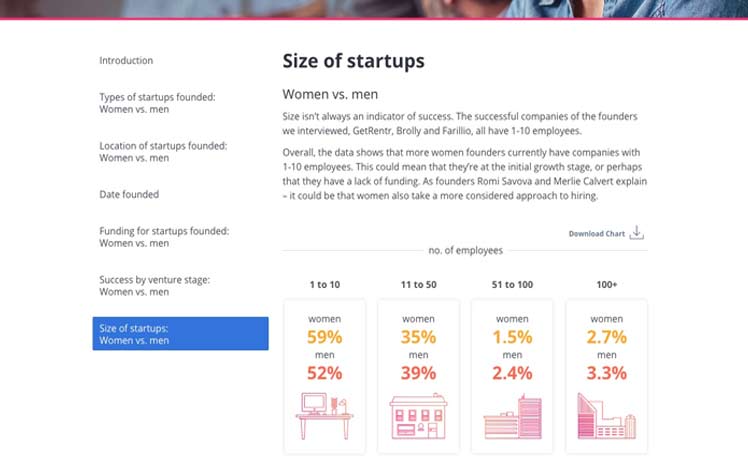Understand what’s missing and meet that need
How often do you stop and really consider your competitive landscape from the point of view of your audience? What do they find when they look for answers relating to your product or service?
Sometimes, to spot opportunities all you need to do is to actually go and read your competitors’ content. When doing so, ask yourself: what’s missing? Better yet, ask your customers directly with focus groups, surveys and user experience testing.
Once you’ve found the gaps, fill them. Upgrade the existing content to meet your audience’s requirements and then delight them with extra value-adds like this explainer video which we produced for Bimuno, or useful downloadable assets like this risk planning template we made for Towergate Insurance.
Bring valuable, old content bang up to date
Articles go out of date, fast. Bitcoin stories are updated every five minutes and fashion fads are irrelevant within the week. Even on the slower side, travel trends last maybe a few months and seasonal pieces need to be updated once a year. All of this presents a fantastic opportunity: no matter what the topic, I’m willing to bet you’ll find that your competitors rely on out of date articles to meet your audience’s demands.
Once you’ve found the gaps, you simply need to inject some updated information. You can do this in a couple of ways:
- Create your own up to date version of the article to distribute as necessary
- Collaborate with relevant publications in your competitive landscape to update old articles with your own data and expertise
Bonus tip: To make sure your own content stays up to date, I’d recommend adding ‘best before dates’ to each article in your editorial plan so you can keep track of expiry.
Add authority to half-hearted articles
If you have access to expert insights within your niche, use that to add authority wherever it is currently lacking. For example, in the health and wellness sector, most awareness-stage content tends to be written by generalist health magazine editors. As a health provider, you can use your authority and expertise to enhance the content landscape.
For example, we recently worked with MacWorld to update their fitness tracker page with fresh data from Vitality Health Insurance.

How to add authority to articles:
- Reference and link to reputable sources
- Back up all claims with robust data
- Include the date published and date updated to indicate freshness
- Include named authors and peer reviewers on YMYL articles
Find frustrating layouts and improve usability
It’s 2019, yet audiences are still subjected to deeply frustrating experiences when they consume information online. Site speeds are painfully slow, navigation is often clunky and valuable information is hidden deep within reams of copy.
You can make it better. Take that cumbersome article and make it accessible – seamless UX will not only keep your users happy, it will likely lead to more conversions. Combine insights from GA with Hotjar recordings to make data-driven decisions about how best to present the information on your own site.
Take an international story and localise it
Depending on your niche and your target market, you may find that your competitive landscape is full of less-than-relevant international content, especially in organic search results pages.
I’ve found that US publications tend to feature heavily in some UK and Australian search results pages simply because there’s not enough quality local content to compete. If this is the case for your key topics, congratulations, you’ve found a fantastic quick-win opportunity to reinvent that US content for your local audience.
The same is true for regional information – take useful London-centric information and replicate using your local expertise.
As an example, we recently adapted a story about broadband speeds to secure wide-ranging coverage and links in regional publications for a broadband provider.
Untangle dense information with a digestible format
Found a big data set or research paper that you know your audience would find useful but might struggle to decipher or even access? Brilliant news, all you have to do is extract the key information and present it in a format that is more accessible and appealing to your audience.
For example, this article Women of UK Startups by Superscript pivoted and refined dense Crunchbase data into simple data visualisations to tell the story of the gender gap in UK startups.

Collaborate with the competition in highly competitive spaces
If the existing piece of content you’re looking to update belongs to an indirect competitor or a publisher with a strong domain, you can always join forces and collaborate with them directly to improve the competitive landscape together.
For example, as part of a recent editorial strategy for an Australian travel client, I found this 2013 BusinessInsider.com.au article ranking position two for the term ‘popular tourist attractions’. The average domain authority for competitors in the search results is high, so my recommendation is to collaborate with Business Insider to get the article updated by offering unique data and expert commentary.

Take a proven concept and adapt it for your niche
As we’ve seen, good ideas are already out there. Sometimes, all you need to do is take one and apply it to your niche.
If you see something in the wild that you love, ask yourself: ‘how could I make that work for my audience?’ For example:
- Consider a spin-off: if you’re a haberdashery, why not produce Tasty style videos for crafts?
- Apply a well-designed format like this Tube map for salaries to your niche.
- Take a simple idea such as a CV template and scale it, just like we’ve done with Monster’s industry-specific downloadable templates here.
Hopefully these tactics will help reduce the time it takes you to produce effective editorial content and delight your audiences by ramping up quality across your niche.
If you’re not sure where to start looking for these kinds of opportunities in your own competitive landscape, get in touch and we can help!

Stuart
There’s very little content online that is original, and that’s not necessarily a bad thing. I agree that repurposing content has a place as long as you are improving on the original idea/concept. It’s like re-making a movie or “borrowing” a riff from a song, if it’s helping you to create something even better then I say go for it.